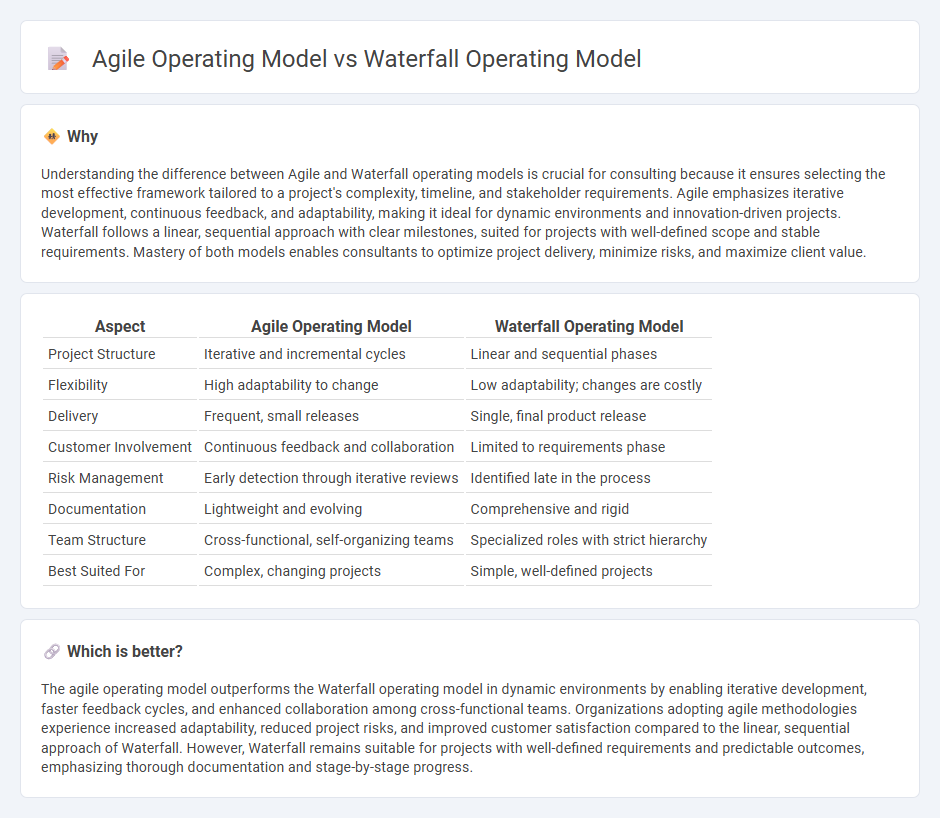
The Agile operating model emphasizes iterative development, flexibility, and continuous feedback, enabling teams to adapt quickly to changing requirements and deliver incremental value. In contrast, the Waterfall operating model follows a linear, sequential approach with distinct phases, focusing on thorough planning and documentation before implementation. Discover how choosing the right operating model can transform project success and organizational agility.
Why it is important
Understanding the difference between Agile and Waterfall operating models is crucial for consulting because it ensures selecting the most effective framework tailored to a project's complexity, timeline, and stakeholder requirements. Agile emphasizes iterative development, continuous feedback, and adaptability, making it ideal for dynamic environments and innovation-driven projects. Waterfall follows a linear, sequential approach with clear milestones, suited for projects with well-defined scope and stable requirements. Mastery of both models enables consultants to optimize project delivery, minimize risks, and maximize client value.
Comparison Table
| Aspect | Agile Operating Model | Waterfall Operating Model |
|---|---|---|
| Project Structure | Iterative and incremental cycles | Linear and sequential phases |
| Flexibility | High adaptability to change | Low adaptability; changes are costly |
| Delivery | Frequent, small releases | Single, final product release |
| Customer Involvement | Continuous feedback and collaboration | Limited to requirements phase |
| Risk Management | Early detection through iterative reviews | Identified late in the process |
| Documentation | Lightweight and evolving | Comprehensive and rigid |
| Team Structure | Cross-functional, self-organizing teams | Specialized roles with strict hierarchy |
| Best Suited For | Complex, changing projects | Simple, well-defined projects |
Which is better?
The agile operating model outperforms the Waterfall operating model in dynamic environments by enabling iterative development, faster feedback cycles, and enhanced collaboration among cross-functional teams. Organizations adopting agile methodologies experience increased adaptability, reduced project risks, and improved customer satisfaction compared to the linear, sequential approach of Waterfall. However, Waterfall remains suitable for projects with well-defined requirements and predictable outcomes, emphasizing thorough documentation and stage-by-stage progress.
Connection
The Agile operating model and Waterfall operating model are connected through their approach to project management and delivery, with Agile emphasizing iterative development and flexibility, while Waterfall follows a linear, sequential process. Organizations often blend elements from both models to tailor workflows that balance adaptability with structured planning, enhancing responsiveness and control. Understanding this connection enables consulting firms to recommend hybrid methodologies that optimize project outcomes based on specific client needs and industry requirements.
Key Terms
Sequential Phases (Waterfall)
The Waterfall operating model emphasizes a linear, sequential approach where each phase, such as requirement analysis, design, implementation, and testing, is completed before moving to the next, ensuring thorough documentation and clear milestones. This model suits projects with well-defined requirements and predictable outcomes but can lack flexibility in adapting to changes during development. Explore the advantages and challenges of the Waterfall versus Agile models to determine the best fit for your project needs.
Iterative Sprints (Agile)
Waterfall operating model follows a linear, sequential approach with distinct phases, while Agile operating model emphasizes iterative sprints for continuous delivery and adaptation. Iterative sprints in Agile enable teams to rapidly develop, test, and refine features in short cycles, improving responsiveness to change and stakeholder feedback. Discover how leveraging iterative sprints can transform project outcomes by fostering flexibility and collaboration.
Change Adaptability
The waterfall operating model follows a linear, sequential approach where change adaptability is limited due to its rigid phase divisions and upfront planning. In contrast, the agile operating model embraces iterative development and continuous feedback, enabling rapid response to evolving requirements and market conditions. Explore further to understand how each model impacts organizational flexibility and project success.
Source and External Links
What is the Waterfall Model? Definition and Guide - TechTarget - The Waterfall operating model is a linear, sequential software development approach with seven stages: requirements, analysis, design, coding and implementation, testing, deployment, and maintenance, each completed fully before moving to the next phase.
Waterfall methodology -- project management - This model follows a fixed, chronological process where phases like requirements gathering, design, implementation, testing, and deployment proceed sequentially without overlapping, emphasizing upfront clarity and independent team work.
Complete Guide To The Waterfall Methodology | monday.com Blog - The Waterfall operating model typically consists of five key phases--requirements, design, implementation, verification, and maintenance--where clear deliverables and timelines are defined at each stage and one phase must be completed before the next begins.
 dowidth.com
dowidth.com